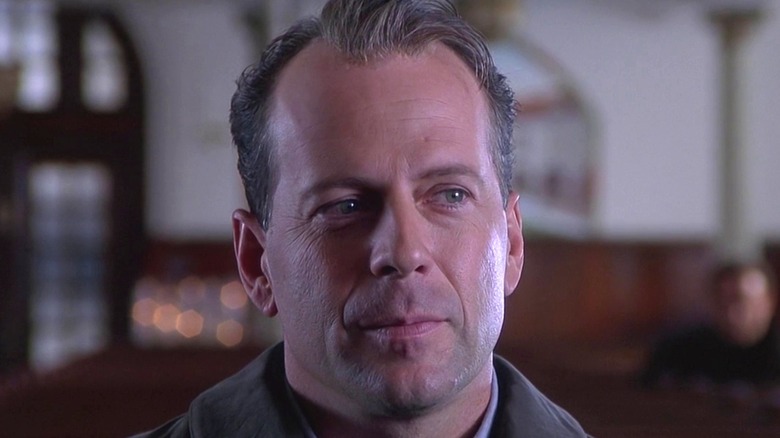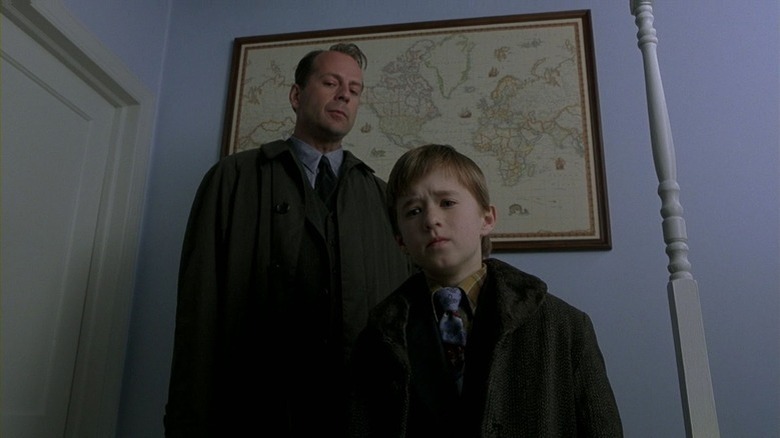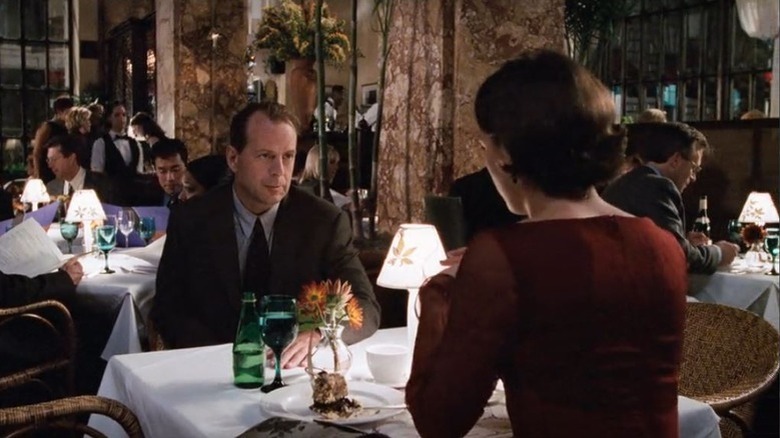The Big Clue Everyone Missed Early In The Sixth Sense
Sometimes, a movie leaves such an indelible mark on pop culture that just one line of dialogue is all that's needed to remember it, and to understand its legacy. For instance, everyone knows you're referencing M. Night Shyamalan's career-defining film "The Sixth Sense" when you say "I see dead people," just as everyone remembers the first time they saw the movie — and the shock that ensued when they reached the end of the film, only to realize Bruce Willis' Dr. Malcolm Crowe had been dead the whole time. It's a reveal that forces viewers to reevaluate what they thought they knew, and thus redefines the entire movie.
For most of the film, Malcolm, a well regarded child psychologist, is seen working with a young boy — Haley Joel Osment's Cole Sear — who believes he can see dead people. It never occurs to anyone watching the movie (at least, back in 1999) that Malcolm himself might be one of those dead people. And this is despite the fact the character is shot by a former patient in the opening minutes of the film.
The point is, much like the ghosts who don't know they're dead, we also only see what we want to see, and that is this — Bruce Willis, well known action hero, surviving the exchange with Donnie Wahlberg's Vincent Gray in the opening minutes. That's why we assume he's alive, until the twist occurs. However, the clues that he did not live were there all along, and one stands out in particular.
This is the big clue everyone missed early in "The Sixth Sense."
No one speaks to or interacts with Malcolm but Cole for the majority of the film
"The Sixth Sense" is filled with clues throughout the film that, once you know to look for them, clearly reveal that Malcolm is deceased, and that he didn't survive being shot in the opening sequence. For one, there's the recurring visual motif of the color red to signify the supernatural. There's the fact Malcolm cannot open the basement door to access his office. There's Cole literally telling Malcolm, "I see dead people."
In hindsight it's all very obvious. But the clues are so clever and so subtle that without that little bit of context, they appear to exist well within the bounds of normal everyday human interaction. Viewers either don't notice or think nothing of the fact that Malcolm doesn't interact with anyone but Cole — or that no one reacts to him when they're in the same room — so it never occurs to them that he might be one of the very dead people that Cole is talking about.
The best example is Malcolm's relationship with his wife
There are examples of people not acknowledging Malcolm throughout the film. For instance, in one scene he's sitting with Cole's mom (Toni Collette) when Cole arrives home, but we never see them communicating, and Cole doesn't respond to Malcolm until she leaves the room. It's obvious now that she never knew he was there.
However, the best example of this pattern of non-interaction involves Malcolm's wife, Anna (Olivia Williams).
We're led to believe Malcolm's marriage has grown cold since he was shot. Anna seemingly won't speak to him. She sleeps alone. And at one point we see her embracing another man. None of this is particularly strange — even if it is depressing — so we think nothing of it. But the key piece of evidence that Malcolm is dead comes when he arrives late to his anniversary dinner, and Anna doesn't acknowledge him. He attempts to pay but she grabs the check before he can. Upon first viewing, the sequence isn't noteworthy. We assume Anna is angry with him for being late. But once you know that Malcolm is dead, you can see the sequence of events for what they are: a wife in mourning sitting alone on her anniversary. She cannot see or hear Malcolm, so she doesn't respond to him.
Once you know where to look for them, the clues are everywhere. It's brilliant and one of the reasons the twist ending of "The Sixth Sense" became such a major part of pop culture.


